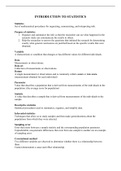College aantekeningen
Introduction to Statistics Summary
- Instelling
- Tilburg University (UVT)
This summary contains all the theoretical information you need to pass this course + demonstrations on how to solve exercises. I passed the course with 8.5.
[Meer zien]





